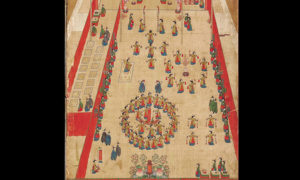This exhibition was organized by the Asian Art Museum in collaboration with the National Museum of Korea and the National Palace Museum of Korea based on the exhibition Scenes of Banquets and Ceremonies of the Joseon Period held by the National Museum of Korea in 2009.
Exhibition Lenders:
Dong-A University Museum 동아대학교박물관
Jangseogak Archives, the Academy of Korean Studies 한국학중앙연구원 장서각
Korea University Museum 고려대학교박물관
Kyujanggak Institute for Korean Studies, Seoul National University 서울대학교 규장각
Leeum, Samsung Museum of Art 삼성미술관 리움
Los Angeles County Museum of Art
Museum of Korean Embroidery 한국자수박물관
National Gallery of Art, Washington D.C.
National Museum of Korea 국립중앙박물관
National Palace Museum of Korea 국립고궁박물관
National Folk Museum of Korea 국립민속박물관
Sookmyung Women’s University Museum 숙명여자대학교박물관
Presentation at the Asian Art Museum is made possible with the generous support of Koret Foundation, Samsung, The Korea Foundation, The Bernard Osher Foundation, E. Rhodes and Leona B. Carpenter Foundation, Silicon Valley Bank, Jamie and Steve Chen, John and Barbara Osterweis, and Suno Kay Osterweis.























